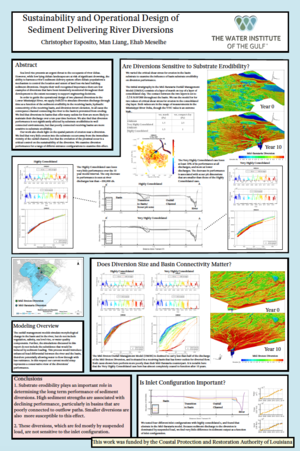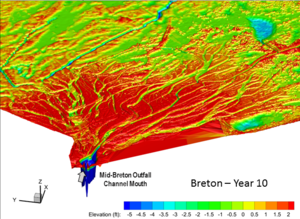Annualmeeting:2017 CSDMS meeting-111
Browse abstracts
Sustainability and Operational Design of Sediment Delivering River Diversions

Sea level rise presents an urgent threat to the occupants of river deltas. However, while low lying deltaic landscapes are at risk of significant drowning, the ability to harness a river’s sediment delivery system offers deltaic populations a mechanism to control the location and extent of land loss via land building sediment diversions. Despite their well-recognized importance there are few examples of diversions that have been intensively monitored throughout their development to the extent necessary to support engineering decisions.
In order to guide the operational design of two planned diversions in the Lower Mississippi River, we apply Delft3D to simulate diversion discharge through time as a function of the characteristics of the receiving basin. In both cases the conveyance channel connecting the river to the basin is prevented from eroding.
We find that diversions in basins that offer many outlets for flow are more likely to maintain their discharge over a ten-year time horizon. We also find that diversion performance is not significantly affected by substrate erodibilities in the range of those found in the Mississippi River Delta, but that artificially increased bed strength would lead to decreases in performance. Our work also sheds light on the spatial pattern of erosion near a diversion. We find that very little erosion into the substrate occurs away from the immediate vicinity of the outfall channel, but that the evolution of the proximal scour is a critical control on the sustainability of the diversion. Ecological considerations suggest that operating diversions at low flow might be useful, but this practice increases the risk of back flow from the receiving basin.

